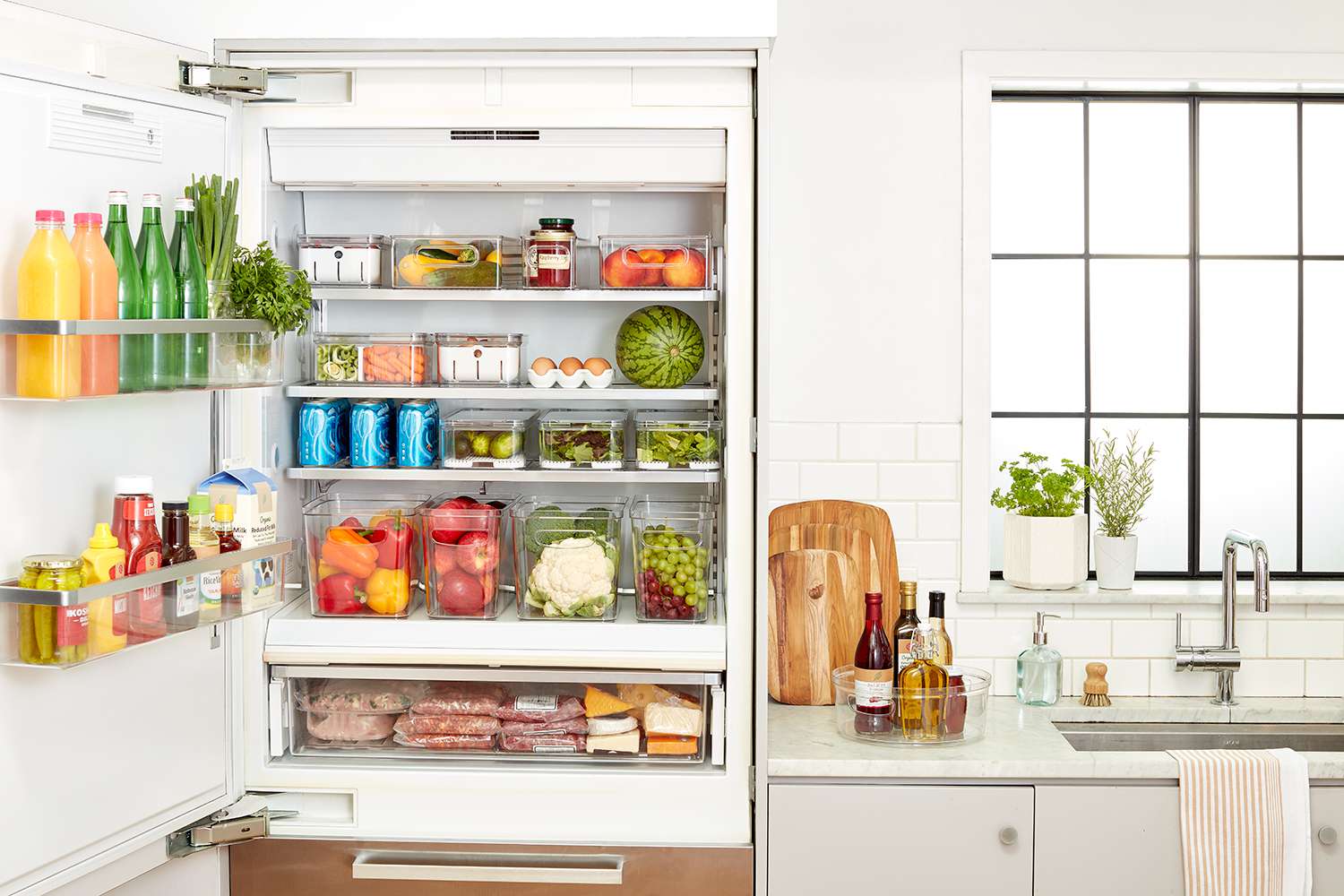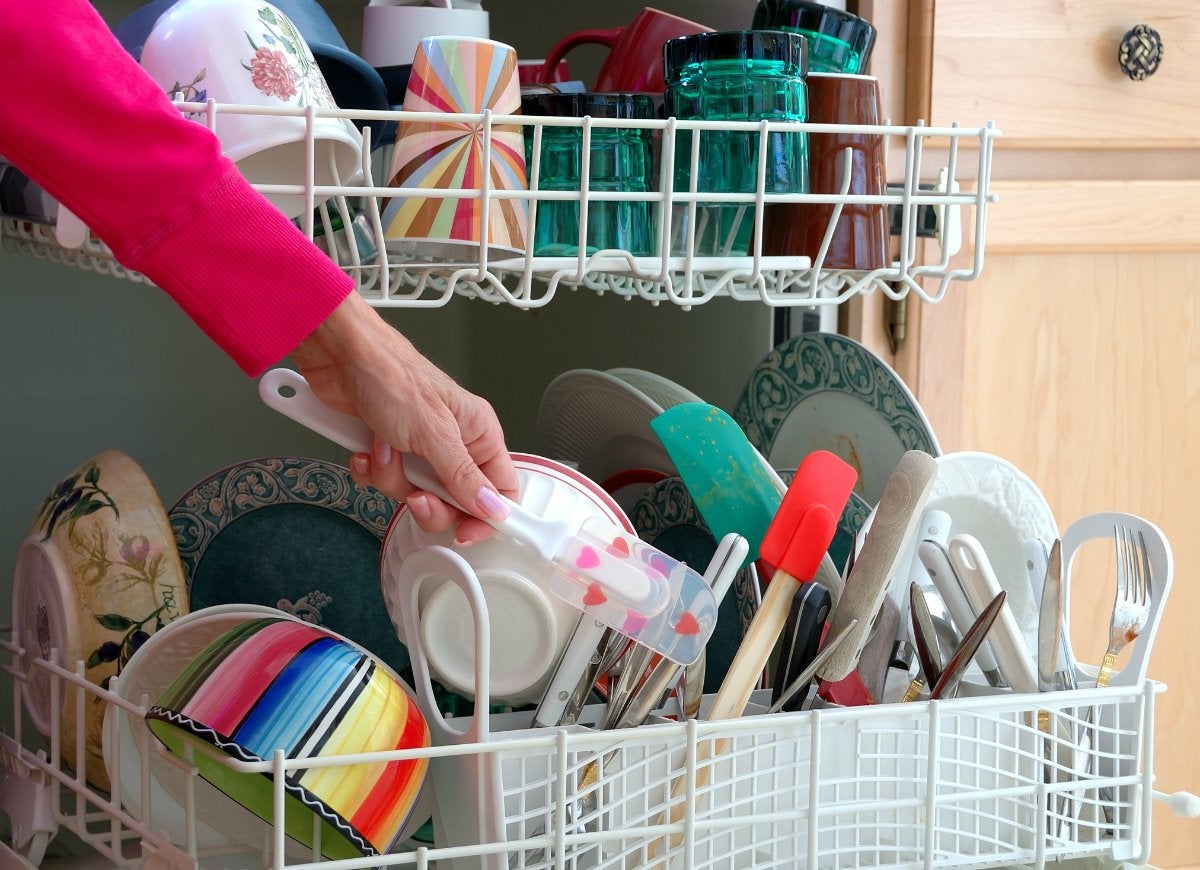Home>Storage Ideas>Kitchen Storage>Refrigerator Organizing Mistakes To Avoid, According To Pros


Kitchen Storage
Refrigerator Organizing Mistakes To Avoid, According To Pros
Modified: August 27, 2024
Avoid these refrigerator organizing mistakes and get expert tips on kitchen storage ideas from the pros!
(Many of the links in this article redirect to a specific reviewed product. Your purchase of these products through affiliate links helps to generate commission for Storables.com, at no extra cost. Learn more)
Introduction
Welcome to the world of kitchen organization! If you have ever struggled to find that missing ingredient or been overwhelmed by the chaos inside your refrigerator, this article is for you. Keeping your kitchen storage organized is not just visually appealing but also incredibly practical. With a well-organized kitchen, you can minimize waste, save time, and make cooking a breeze.
One area in the kitchen that often requires extra attention is the refrigerator. It’s easy for this essential appliance to become a black hole of forgotten leftovers, expired condiments, and haphazardly placed food items. But fear not! We have consulted the experts and compiled a list of refrigerator organizing mistakes to avoid. By understanding and rectifying these mistakes, you can transform your fridge into a well-organized and efficient space.
So, let’s jump in and learn how to avoid these common pitfalls and keep your refrigerator running smoothly.
Key Takeaways:
- Avoid overstuffing your fridge by decluttering regularly and using clear, stackable containers for better visibility and air circulation. A clutter-free fridge saves time, money, and makes meal planning a breeze.
- Maintain food freshness by understanding temperature zones, proper storage, and labeling items. Regular cleaning, utilizing organizational tools, and choosing appropriate containers are key to an efficient and well-organized refrigerator.
Mistake #1: Overstuffing the Refrigerator
One of the most common mistakes people make when organizing their refrigerator is overstuffing it. It’s tempting to try and cram as many items as possible into the limited space, but this can lead to several issues.
Firstly, an overcrowded refrigerator makes it difficult to see and access items at the back. This often leads to food wastage as items get forgotten and pushed to the back, only to be discovered weeks later when they are no longer edible. Additionally, overcrowding can cause poor air circulation, leading to uneven cooling and potentially spoiling food faster.
To avoid this mistake, it’s important to declutter your fridge regularly. Start by removing expired and moldy items, and then assess what you really need to keep. Consider whether each item really needs to be refrigerated or if it can be stored in a different area of the kitchen. This will help create a more organized and spacious environment that allows for proper air circulation and ease of use.
Next, make use of storage solutions to maximize the space in your refrigerator. Invest in clear, stackable containers, which not only help keep similar items together but also allow for better visibility, making it easier to find what you need. Use organizers like bins or baskets to group similar items together, such as condiments, dairy products, or snacks. Labeling these containers and shelves can also help you quickly locate the items you need and ensure everything stays in its designated place.
Remember, a clutter-free and well-organized refrigerator not only saves you time and money but also makes meal planning and preparation a breeze.
Mistake #2: Neglecting Proper Food Storage
Proper food storage is essential for maintaining the freshness, quality, and safety of your food items. Unfortunately, many people neglect this aspect when organizing their refrigerator, leading to potential issues such as food spoilage and cross-contamination.
One common mistake is storing raw meats and seafood on the top shelf or above ready-to-eat foods. Raw meats can potentially drip or leak, contaminating the foods below and increasing the risk of foodborne illnesses. To avoid this, always store raw meats and seafood in sealed containers or bags on the bottom shelf, where any potential drips will not come into contact with other foods.
Additionally, it’s important to store fruits and vegetables properly to maintain their freshness. Some fruits produce ethylene gas, which can cause nearby vegetables to ripen faster or spoil. To prevent this, store fruits and vegetables separately and consider using produce storage bags or containers with adjustable humidity levels to help extend their shelf life.
Another common mistake is not using airtight containers or wraps to store leftover foods. Leaving leftovers uncovered or in loosely sealed containers can cause them to dry out, lose flavor, or become contaminated by other odors in the refrigerator. Invest in a set of high-quality airtight containers or use cling wrap to keep leftovers fresh for longer.
Remember to always follow the recommended storage guidelines for different food items. Check the labels or conduct a quick online search to determine the appropriate temperature and storage recommendations for various fruits, vegetables, meats, and dairy products.
By paying attention to proper food storage guidelines, you can keep your food fresh, minimize waste, and reduce the risk of foodborne illnesses.
Mistake #3: Ignoring Temperature Zones
Did you know that your refrigerator has different temperature zones? Many people make the mistake of treating their fridge as one uniformed space, not realizing that certain areas are colder or warmer than others. Understanding these temperature zones and utilizing them correctly can help optimize the freshness and longevity of your food.
The coldest area in your refrigerator is typically the back of the bottom shelf or the crisper drawers. This is where you should store items that need to be kept at a lower temperature, such as raw meats, poultry, and seafood. Placing these items in this colder zone helps to prevent bacterial growth and maintain their quality for longer.
The middle shelves of your fridge tend to have a slightly higher temperature. This is an ideal spot for items like dairy products, deli meats, and leftovers. These foods still need to be kept cold, but they don’t require the coldest temperature. By placing them in the middle shelves, you ensure that they are easily accessible and at the right temperature for consumption.
The door shelves of your refrigerator are the warmest areas. This is because the temperature fluctuates every time you open the door, making it less suitable for some food items. While it’s convenient to store condiments and other non-perishable items on the door, it’s not recommended to keep highly perishable foods like eggs or milk there. Instead, reserve the door shelves for items with a longer shelf life, such as condiments, pickles, or bottled beverages.
By paying attention to the temperature zones in your refrigerator and storing your items accordingly, you can ensure that each food item is in an optimal environment for freshness. This simple adjustment can significantly extend the shelf life of your groceries and reduce food waste.
Mistake #4: Failing to Label and Date Items
One of the most common mistakes when it comes to refrigerator organization is neglecting to label and date items. It may seem like a small detail, but it can make a big difference in maintaining a well-organized and efficient fridge.
When we store food items in the refrigerator, it’s easy to forget when we bought them or when they were prepared. Without proper labeling and dating, it becomes increasingly difficult to keep track of the freshness and safety of the food. This can lead to consuming expired or spoiled products, which can be both unpleasant and potentially harmful.
To avoid this mistake, it’s important to develop the habit of labeling and dating items as soon as you store them in the refrigerator. Use adhesive labels or even masking tape to mark each container with the contents and the date it was stored. This simple step allows you to quickly identify what’s inside the container and how long it has been there.
Labeling and dating are especially important for leftovers. By clearly marking the contents and the date they were cooked or stored, you can easily keep track of their freshness. This not only helps in preventing food waste but also ensures that you consume leftovers within a safe timeframe.
Moreover, labeling and dating items can assist in meal planning. When you can easily see what foods are available and how long they have been stored, you can plan your meals effectively and use up items before they spoil. This minimizes food waste and saves you money in the long run.
Remember, taking a few seconds to label and date items in your refrigerator can save you time, money, and potential foodborne illnesses. It’s a small but impactful step towards maintaining an organized and efficient kitchen.
Mistake #5: Disregarding Regular Cleaning
We often underestimate the importance of regular cleaning when it comes to organizing our refrigerators. It’s easy to forget about the hidden messes and spills that accumulate over time, but disregarding regular cleaning can lead to numerous problems.
One common mistake is neglecting to wipe spills and stains immediately. When liquids or foods spill inside your refrigerator, they can seep into crevices and corners, creating an environment for bacteria to thrive. Over time, these spills can become breeding grounds for germs and unpleasant odors. To avoid this, be diligent in cleaning up spills as soon as they happen. Use warm soapy water or a mild cleaning solution to wipe down the affected areas and ensure they are thoroughly dry before restocking.
Another mistake is completely ignoring the regular cleaning of your fridge. It’s important to set aside some time every few months to give your refrigerator a deep clean. Empty the contents, remove the shelves and drawers, and wash them with warm, soapy water. Wipe down the interior surfaces of the refrigerator with a cleaning solution, paying attention to corners, seals, and other areas that tend to accumulate dirt and grime. Don’t forget to clean the door seals as well. Once everything is cleaned and dried, replace the shelves and drawers and restock the refrigerator with fresh and organized items.
Regular cleaning not only helps maintain a pleasant and hygienic environment but also prevents the growth of mold, mildew, and bacteria. It also allows you to properly assess the contents of your fridge, discard any expired or spoiled items, and reorganize it effectively.
Additionally, a clean refrigerator is more efficient. A buildup of dirt or debris on the condenser coils, located at the back or bottom of the fridge, can reduce cooling efficiency and lead to higher energy consumption. Regularly vacuum or brush these coils to keep them clean and functioning optimally.
Make it a habit to incorporate regular cleaning into your refrigerator organization routine. It will not only keep your fridge clean and hygienic but also contribute to its overall efficiency and prolong its lifespan.
When organizing your refrigerator, avoid overfilling shelves and drawers, as this can block airflow and lead to uneven cooling. Keep space for air to circulate and maintain food freshness.
Mistake #6: Using the Door Shelves Incorrectly
The door shelves in your refrigerator are often an underutilized space. Many people make the mistake of using them incorrectly, which can lead to inefficiencies in organization and compromised food safety.
One common mistake is storing highly perishable items on the door shelves. As mentioned earlier, the door shelves are the warmest areas of the refrigerator due to temperature fluctuations when the door is opened. Placing highly perishable items such as milk, eggs, and raw meat on the door shelves can expose them to inconsistent temperatures, increasing the risk of spoilage.
Instead, reserve the door shelves for items with longer shelf lives, such as condiments, sauces, and bottled beverages. These items are typically more stable and can withstand the temperature fluctuations better.
Another mistake is overloading the door shelves with too many items. While it may seem convenient to store various jars and bottles on the door, overcrowding can make it difficult to access items and lead to frequent spills. It’s important to create enough space between items to prevent them from tipping over or becoming jammed together.
To maximize the use of your door shelves, consider using organizers or bins designed specifically for this purpose. These organizers help keep items upright, prevent spills, and make it easier to access and retrieve what you need. By utilizing these organizers, you can create a neat and efficient storage system on your refrigerator door.
Lastly, be mindful of the weight of the items stored on the door shelves. Overloading them with heavy items can strain the hinges and affect the overall functionality of the refrigerator door. It’s important to distribute the weight evenly and avoid placing excessive weight on the door shelves.
By using the door shelves correctly and purposefully, you can optimize the storage space in your refrigerator while ensuring that food items remain fresh and safe for consumption. Take advantage of this often neglected space to enhance your overall refrigerator organization.
Mistake #7: Not Maintaining Proper Air Circulation
Proper air circulation is crucial for maintaining the optimal temperature and freshness of the contents in your refrigerator. Unfortunately, many people overlook this aspect of refrigerator organization, leading to potential issues with food spoilage and inefficient cooling.
One common mistake is blocking the air vents inside the refrigerator. These vents are designed to facilitate the flow of cold air throughout the unit, ensuring that all areas are evenly cooled. However, when these vents are blocked by overcrowding or improperly placed items, it can disrupt the air circulation and lead to temperature inconsistencies. This can result in certain areas becoming too warm while others remain too cold.
To avoid this mistake, make sure to arrange your items in a way that allows for proper airflow. Avoid placing tall items directly in front of the vents and leave some space between items to allow air to circulate freely. By maintaining proper air circulation, you can ensure that your food stays fresh and maintains its quality for a longer period of time.
In addition to arranging items properly, it’s also essential to keep the back of your refrigerator clear. The condenser coils, located at the back or bottom of the fridge, generate heat as they work to cool the unit. If these coils are covered in dust or debris, it can impede the cooling process and reduce the overall efficiency of the refrigerator. Regularly vacuum or brush the coils to remove any buildup and maintain proper airflow.
Furthermore, it’s important to ensure that the door seals are in good condition. Damaged or worn-out seals can allow air to escape, causing temperature fluctuations and reducing the effectiveness of your refrigerator. Check the seals regularly and replace them if necessary to maintain proper air circulation.
By paying attention to maintaining proper air circulation, you can ensure that your refrigerator operates efficiently and your food stays fresh and safe to consume. It’s a simple yet crucial step in effective refrigerator organization.
Mistake #8: Storing Foods in Inappropriate Containers
The containers we use to store our food in the refrigerator play a significant role in maintaining its freshness and quality. However, many people make the mistake of using containers that are not suitable for storing specific types of foods, leading to issues such as cross-contamination, premature spoilage, and flavor transfer.
One common mistake is storing acidic or highly-flavored foods in plastic containers. Acidic foods like tomatoes, citrus fruits, or vinegar-based dressings can react with certain plastics, causing them to break down and release harmful chemicals into the food. To avoid this, opt for glass or stainless steel containers when storing acidic or highly-flavored foods. These materials are non-reactive and will not compromise the quality or safety of your food.
Similarly, using open containers or bowls without lids can expose food to air and moisture, leading to faster spoilage. Additionally, it can also cause odors to permeate through the refrigerator, resulting in flavor transfer between different food items. Invest in a set of airtight containers with secure lids to maintain the freshness of your food and prevent unwanted odors from spreading.
Another mistake is transferring hot or warm leftovers directly into the refrigerator. Placing hot foods in the refrigerator can raise its internal temperature and compromise the overall cooling efficiency. It’s best to allow hot foods to cool at room temperature for a short period of time before storing them in the refrigerator. However, be mindful of the time frame and ensure that food does not stay at room temperature for too long, as this can promote bacterial growth.
When it comes to storing liquids or soups, using improper containers can lead to leaks and spills. Opt for leak-proof containers or ones with secure lids to prevent messy accidents inside your refrigerator. Consider using containers with appropriate dividers or compartments to separate different types of food, preventing them from mixing and affecting their flavors or textures.
By selecting the right container for each type of food, you can ensure that your refrigerator stays organized, your food stays fresh, and the flavors remain intact. Take the time to assess your current storage containers and make any necessary changes to improve your refrigerator organization and food safety.
Mistake #9: Not Taking Advantage of Organizational Tools
One of the biggest mistakes people make when organizing their refrigerator is not utilizing the wide range of organizational tools available. These tools are designed to maximize space, improve accessibility, and keep your fridge tidy and efficient. By neglecting to take advantage of these tools, you may be missing out on valuable opportunities to optimize your refrigerator organization.
One commonly overlooked tool is the humble lazy Susan. This rotating tray can be placed on a shelf to provide easy access to items at the back. It’s perfect for storing condiments, sauces, or even small containers of leftovers. With a simple turn, you can quickly see and reach all the items, eliminating the frustration of digging through the depths of your fridge.
Another organizational tool that is often underutilized is the refrigerator drawer. These drawers, usually located at the bottom of the fridge, are designed to keep fruits, vegetables, and other perishable items fresh and organized. By separating them from the rest of the contents, you can prevent cross-contamination and prolong their shelf life. Take advantage of adjustable humidity settings if your refrigerator has this feature to create the ideal environment for different types of produce.
Clear bins or baskets are another fantastic organizational tool for your refrigerator. They can be used to group and categorize similar items, such as beverages, snacks, or dairy products. These bins not only keep things in order but also make it easier to find what you need without searching through a cluttered fridge. Labeling the bins can further enhance organization and efficiency.
Consider investing in stackable containers to maximize vertical space in your refrigerator. These containers can be used to store leftovers, prepped ingredients, or even individual meal portions. Being able to stack containers helps optimize space and keeps your fridge neat and tidy.
If you have limited shelf space, adjustable shelf dividers are a great solution. These dividers allow you to create customized sections on a shelf, keeping items separated and preventing them from toppling over. They are particularly useful for organizing jars, cans, or smaller items that tend to get lost or pushed to the back.
Lastly, don’t forget about the versatility of magnetic and adhesive hooks. These hooks can be attached to the sides or interior walls of your refrigerator to hang items such as kitchen utensils, potholders, or grocery lists. By utilizing these hooks, you can free up valuable shelf space and keep frequently used items within easy reach.
By incorporating these organizational tools into your refrigerator, you can transform the space into a well-organized and efficient area. They not only optimize storage capacity but also improve accessibility and reduce clutter. Take advantage of these tools to make the most out of your refrigerator organization.
Conclusion
Organizing your refrigerator doesn’t have to be a daunting task. By avoiding common mistakes and implementing effective organization strategies, you can transform your fridge into a well-structured and efficient space. Not only will this make your daily kitchen routines easier, but it will also help reduce food waste, save money, and ensure the freshness and safety of your food.
We’ve explored various refrigerator organizing mistakes to avoid, from overstuffing the fridge to neglecting proper food storage, ignoring temperature zones, failing to label and date items, disregarding regular cleaning, using the door shelves incorrectly, not maintaining proper air circulation, storing foods in inappropriate containers, and not taking advantage of organizational tools.
By being mindful of these mistakes and implementing the suggested solutions, you can create a more functional and orderly refrigerator. Remember to declutter regularly, use proper containers, understand the temperature zones, maintain proper air circulation, label and date items, clean your fridge regularly, and take advantage of the organizational tools available to you.
Organizing your refrigerator not only improves the visual appeal of your kitchen but also enhances your overall cooking experience. With everything in its designated place, you’ll be able to find ingredients faster, waste less food, and efficiently plan and prepare meals. Plus, a well-organized refrigerator makes grocery shopping easier, as you can easily see what you have and what you need to restock.
So, take the time to assess the current state of your refrigerator and begin implementing these organization strategies. With a little effort and consistency, you’ll enjoy the benefits of a well-organized kitchen and an efficiently functioning fridge. Happy organizing!
Frequently Asked Questions about Refrigerator Organizing Mistakes To Avoid, According To Pros
Was this page helpful?
At Storables.com, we guarantee accurate and reliable information. Our content, validated by Expert Board Contributors, is crafted following stringent Editorial Policies. We're committed to providing you with well-researched, expert-backed insights for all your informational needs.














0 thoughts on “Refrigerator Organizing Mistakes To Avoid, According To Pros”